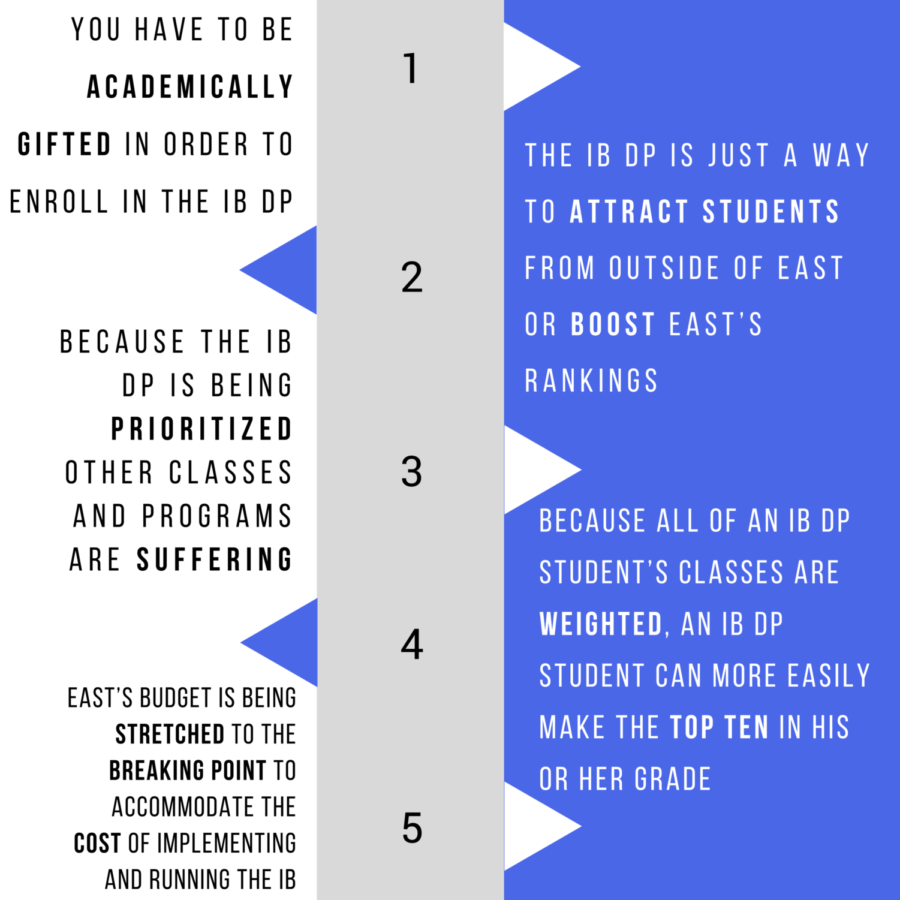IB DP “Mythbusters”
Addressing concerns that the student body has about the IB DP at EGRHS
January 19, 2018
Note: Myths & mythbusters 1-10 can be found in the print edition of the newspaper. Myths & mythbusters 11-15 are only on the web.
Myth #1: You have to be academically gifted in order to enroll in the IB DP.
Mythbuster: The IB DP at East values open enrollment, so no minimum GPA is required in order to enroll. It’s meant to be open and accessible to all students who want to participate. It’s not meant to be an elitist programme; in fact, the whole country of Ecuador has adopted the IB DP.
However, the IB DP is meant to be a rigorous academic programme that prepares a student for college and future life. Therefore a strong work ethic and desire to do well is necessary in order to obtain an IB Diploma.
Myth #2: IB is harder than AP.
Mythbuster: IB presents different challenges than AP, not necessarily harder ones. It depends on the person. IB emphasizes writing in its assessments. AP exams and IB SL exams are both taken in May but IB HL courses are only taken senior year. IB’ additional Creativity, Activity, and Service (CAS) requirement is not difficult because many people have this kind of balance in their lives already.
However, the Extended Essay is a major commitment that might be an additional challenge for some students. According to McKinney, while researching and writing the EE some students became significantly discouraged and overwhelmed.
Myth #3: Juniors and seniors enrolled in the ID DP are only doing it to earn college credit or get into an Ivy League college or university.
Mythbuster: Those in the IB DP chose it due to its unique curriculum which emphasizes skill-based learning as opposed to the content-based learning that the Advanced Placement (AP) emphasizes.
“I did it for the Visual Arts program because I really wanted to do that and the teachers recommended it,” said Madeline Fellows ‘19. “When I learned more about the programme I realized it was better for me to have a more international view and wanted to feel more connected with the rest of the world. I wanted to go deeper and not just memorize things.”
Myth #4: Colleges prefer IB over AP.
Mythbuster: Colleges value both IB and AP courses because both signify academic rigor and risk-taking. They want to see commitment and dedication to one’s interests and strengths throughout one’s high school career. East has had a good track record of students being accepted to the Ivy League and other good schools before the implementation of IB.
Myth #5: The IB DP is just a way to attract students from outside of East into our school district or boost East’s rankings and compete with other academically high-achieving schools.
Mythbuster: The main reason for implementing IB at East was because its mission statement aligns so closely with the East mission statement. It also provides a different and alternate way of learning. According to McKinney, offering both AP and IB courses is similar to offering band, orchestra, and choir. “We have a strong music program overall and we serve more students because we offer these different choices,” she said. “This has been a part of our school community for so long we do not worry, in fact, we take pride in it.”
However, it cannot be denied that bringing IB to East has attracted students here who otherwise might have chosen a different school. Many high-achieving schools on the east side of the state have IB programmes and having IB at East does help compete with these schools. Additionally, through IB it is now possible to compare East to other schools internationally. “This is simply a perk of offering the IB Diploma Programme as opposed to a driving factor,” McKinney said.
Myth #6: Taking classes in the IB DP with the same group of students for two years is boring and irritating.
Mythbuster: “I like taking classes with the same people,” said Olivia Spagnuolo ‘19. “I like how we’re all close-knit and can talk easily with each other because we all know each other so well.”
However, she also admitted that there’s a downside to the small number of IB candidates as well. “It’s hard that you don’t get to see everyone else in the school because you’re always taking classes with IB students,” she said.
Myth #7: It’s not worth having IB at East because very few students do it and/or are interested in doing it.
Mythbuster: IB at East is thriving compared to other schools when they first started their IB programmes. For example, when Portage Central started the IB DP at their school they had only five or six candidates. EGRHS, on the other hand, has a total of 51. This includes 25 students in the Class of 2018 and 26 students in the Class of 2019.
Myth #8: Because all of an IB DP student’s classes are weighted and class rank is determined by each student’s weighted GPA, an IB DP student has an inherent advantage when it comes to making the top ten in his or her grade.
Mythbuster: According to McKinney, there are many factors to consider and questions to answer when deciding the top ten students. This includes: How many honors and AP courses did the student take in 9th and 10th grade? Does an IB DP candidate have an IB course for every semester during their junior and senior year?
The only reason that East began giving courses weight was to help students win scholarships. East students were put at a disadvantage when they did not have their honors and AP courses weighted as compared to other schools. However, most colleges strip the high schools’ grade weights when considering applications, and instead look to the course’s name (if it has “honors,” “IB,” or “AP” in it) to determine rigor.
Myth #9: Because the IB DP is being prioritized other classes and programs are suffering.
Mythbuster: The only classes that have been removed from the East curriculum in direct result of IB are English ⅚ and Honors Spanish ⅚. Despite the implementation of IB, We the People, another Junior class, had 23 participants this year and won the State competition. Additionally, the CAS requirement encourages students to take a more active role in their school communities and join extracurriculars they might have not taken part in otherwise.
Myth #10: East’s budget is being stretched to the breaking point to accommodate the cost of implementing and running the IB. This money could have been used elsewhere.
Mythbuster: The initial costs of researching and attending the IB authorized professional development were paid for with the sale of a cell tower behind the stadium. Now that IB is a part of the school’s day-to-day proceedings, it is being paid for with General fund money which is provided by the State of Michigan.
Myth #11: Once you commit to the IB curriculum you’re locked into the program.
Mythbuster: There’s only one path into the IB programme, and that is declaring your intention to participate in the IB DP sometime during your sophomore year. However, there are two paths out of the programme. Therefore it is possible to switch out of the IB DP sometime during your Junior year, though the longer you wait the harder it is to get out of it. If you do decide to switch out, you will not receive an IB diploma.
Myth #12: IB divides the student body rather than unites them.
Mythbuster: Due to the imbalanced ratio of IB students to regular students at East, the IB programme does divide IB students from the remainder of the student body. However, at other schools where everyone is required to take IB, this is not the case. “Because everyone at my school is enrolled in IB, our view is that we are all in this together and we’re all suffering through it together,” Abby Zoetewey ‘19 from City High said.
Myth #13: The IB DP is a failed attempt at breaking the East “bubble.”
Mythbuster: One intent of the IB is to promote an internationalist mindset in East students, which aligns with East’s mission statement of “educating and inspiring each student to navigate successfully in a global community.” Many IB students have reported that they enjoy the internationalist aspect of IB learning (read what they have to say here and here.) IB DP student Keagan Sullivan ’18 said that IB “has encouraged [him] to see things from points of view [he] could never have pictured before” such as being “taught World War II from the perspective of countries all around the world, even somewhere the US is not seen as a hero.” (Read more of what Keagan has to say about the IB DP here.)
However, East’s lack of diversity means that, for some, classroom learning can only go so far in promoting this kind of internationalist frame of mind. Leo Schneider ‘18, an IB DP student, called the assertion that IB promoted an international perspective “a complete falsehood” and said that he had “yet to experience” any learning that gave him “a deeper, broader cultural understanding.” (You can read more about Leo’s opinion on the IB DP here.)
Myth #14: It’s extremely difficult to get an IB diploma.
Mythbuster: In the May 2017 Statistics Bulletin 78% of students earned the diploma during their May 2017 testing period. (Read more statistics about the IB DP in McKinney’s interview here.) In contrast, the average of most AP exam scores according to the College Board are in the threes and twos, meaning most students don’t qualify for college credit through AP. Therefore, while both IB and AP are good options for getting college credit, it is overall statistically more likely to receive an IB diploma than receive a four or five on an AP test (though obviously international and national statistics will differ from those at EGRHS).
Myth #15: The decision to introduce IB to East was spontaneous and foolhardy.
Mythbuster: Planning for the IB started during the 2007-2008 school year, so it’s been a major, long term project that’s taken a decade of preparation. The first training session was in 2010 and it took three years to complete the authorization process.




